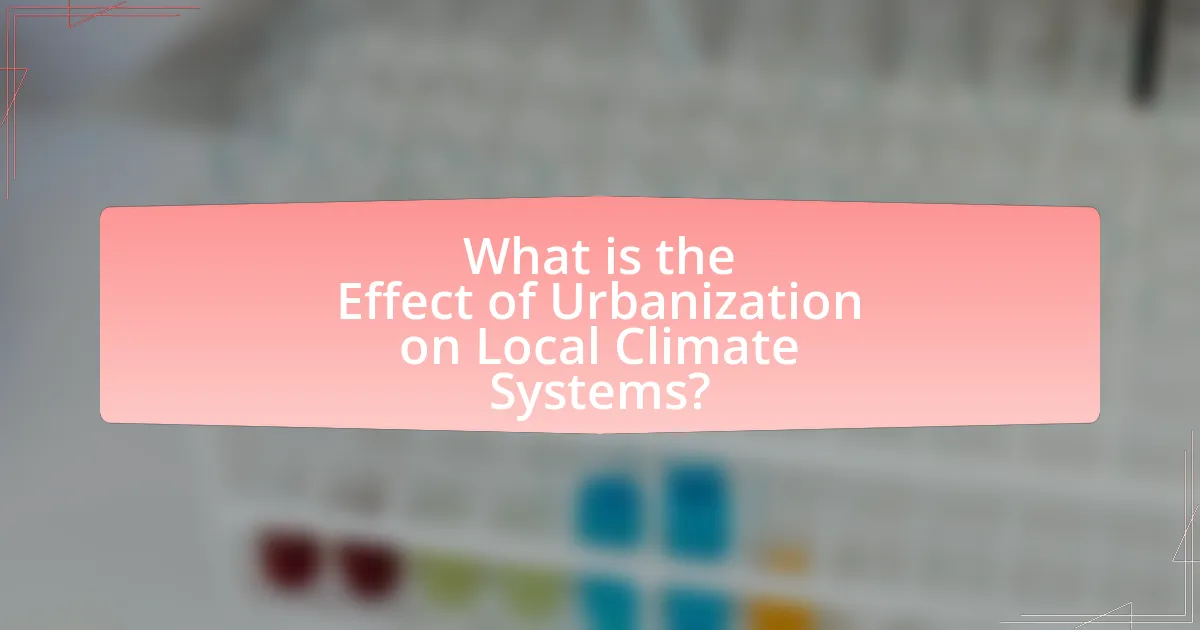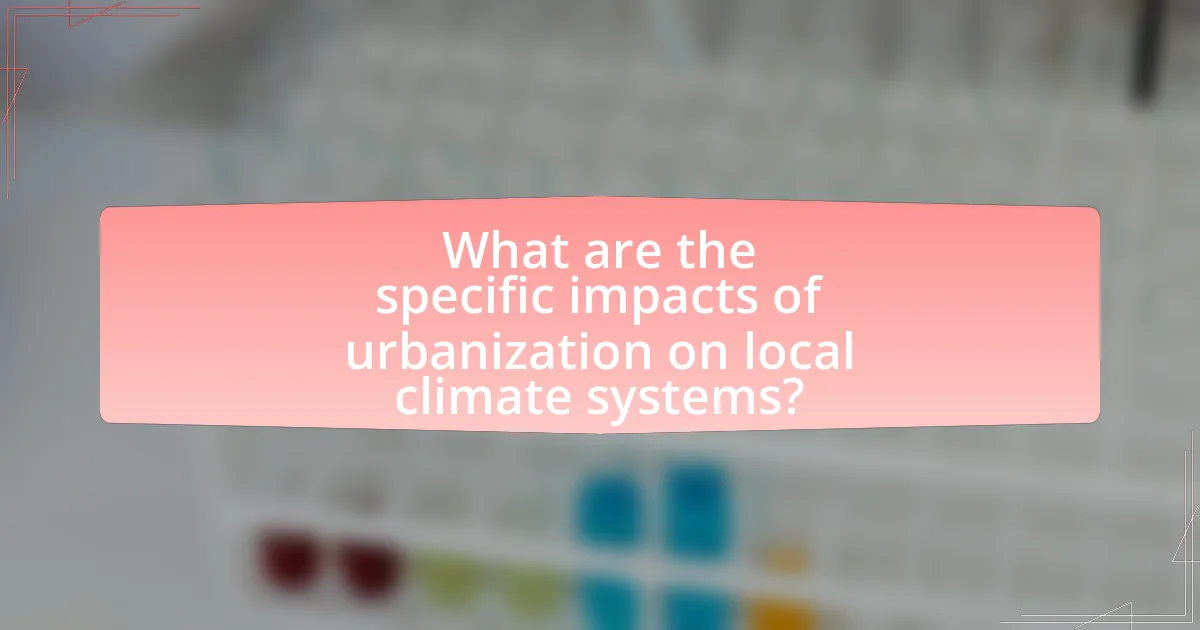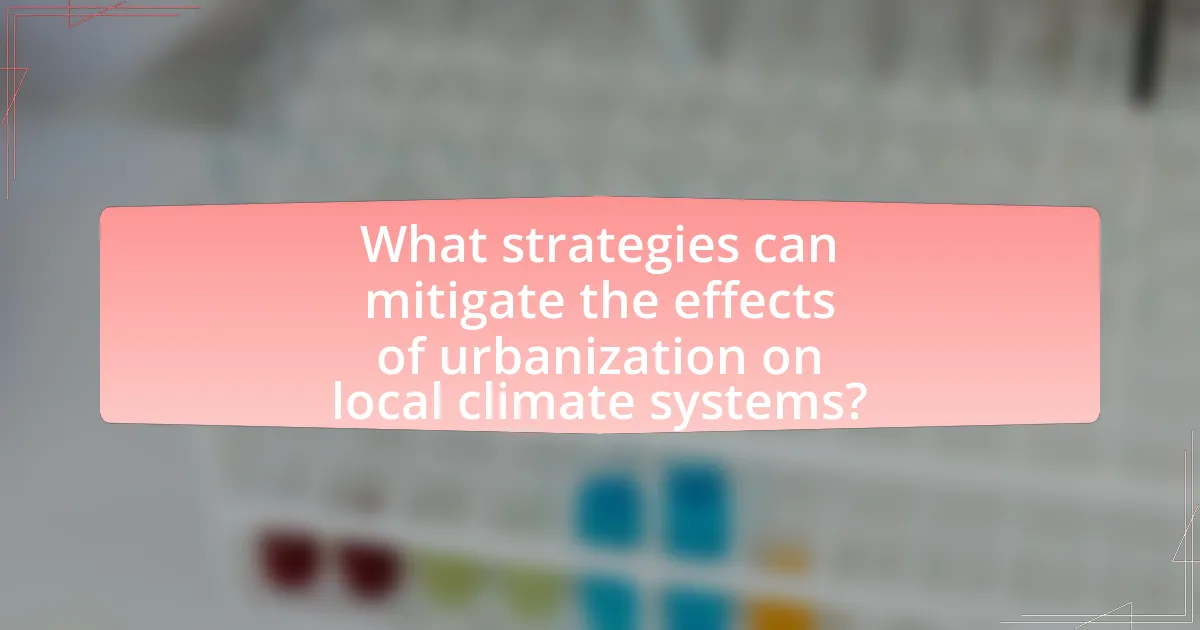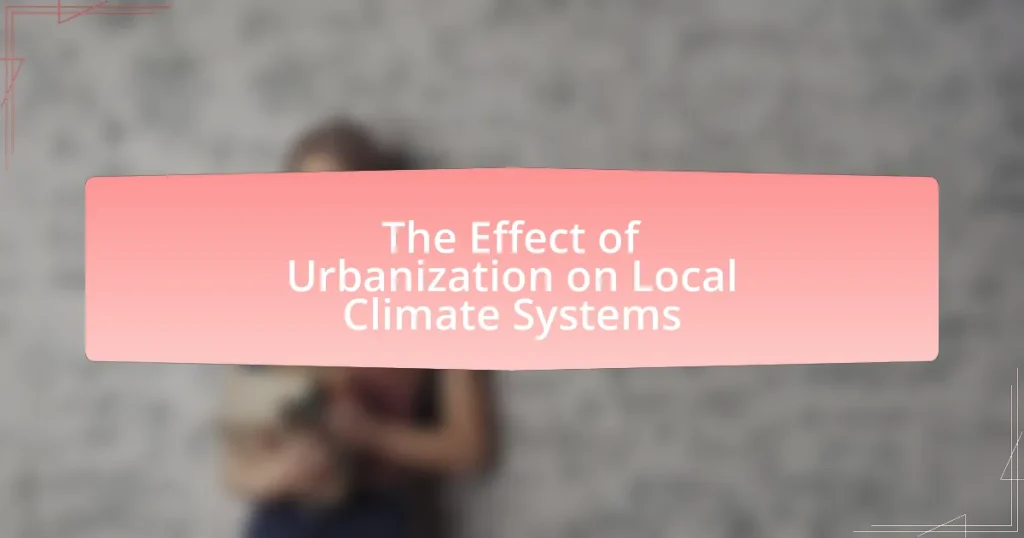Urbanization significantly impacts local climate systems by increasing temperatures, altering precipitation patterns, and affecting air quality. The phenomenon known as the urban heat island effect results in urban areas being 1 to 5 degrees Celsius warmer than their rural counterparts, primarily due to the prevalence of impervious surfaces and reduced vegetation. Additionally, urbanization modifies rainfall distribution, often leading to increased localized precipitation and flooding risks. The article explores the mechanisms behind these changes, including heat retention in urban structures, the influence of land use on hydrology, and the implications for local ecosystems and biodiversity. Understanding these effects is crucial for developing effective urban planning and climate adaptation strategies.

What is the Effect of Urbanization on Local Climate Systems?
Urbanization significantly alters local climate systems by increasing temperatures, modifying precipitation patterns, and affecting wind flows. The urban heat island effect, where urban areas become warmer than their rural surroundings, is a primary consequence, often leading to temperature increases of 1 to 5 degrees Celsius. Additionally, urbanization changes land surfaces, which can lead to altered rainfall patterns due to increased impervious surfaces that reduce natural water absorption. Studies have shown that cities can experience up to 30% more rainfall than surrounding areas due to these changes. Furthermore, urban structures can disrupt natural wind patterns, leading to reduced air circulation and increased pollution levels. These effects collectively demonstrate how urbanization reshapes local climate dynamics.
How does urbanization influence temperature variations in local climates?
Urbanization significantly influences temperature variations in local climates by creating urban heat islands (UHIs), where built environments absorb and retain heat more than natural landscapes. This phenomenon occurs due to factors such as the prevalence of concrete and asphalt, which have lower albedo and higher thermal mass compared to vegetation. Studies indicate that urban areas can be 2 to 5 degrees Celsius warmer than surrounding rural areas, particularly during nighttime, when the heat retained by buildings and roads is released slowly. For example, research conducted by the National Oceanic and Atmospheric Administration (NOAA) highlights that cities like Phoenix and Los Angeles experience pronounced temperature increases due to extensive urbanization, which alters local climate patterns and exacerbates heat-related issues.
What are the mechanisms through which urban areas retain heat?
Urban areas retain heat primarily through the urban heat island effect, which occurs due to several mechanisms. These mechanisms include the absorption and retention of heat by buildings, roads, and other infrastructure made from materials like concrete and asphalt, which have high thermal mass. Additionally, reduced vegetation and green spaces in urban settings limit natural cooling processes, while human activities such as transportation and industrial operations contribute to increased heat generation. Studies have shown that urban areas can be significantly warmer than surrounding rural areas, with temperature differences often exceeding 5 degrees Celsius during the day and even more at night, as reported by the U.S. Environmental Protection Agency.
How do urban heat islands develop and what are their impacts?
Urban heat islands develop primarily due to the concentration of buildings, roads, and other infrastructure in urban areas, which absorb and retain heat more than natural landscapes. This phenomenon is exacerbated by factors such as reduced vegetation, which limits cooling through evapotranspiration, and the use of materials like asphalt and concrete that have high thermal mass. The impacts of urban heat islands include increased local temperatures, which can lead to higher energy consumption for cooling, elevated emissions of air pollutants and greenhouse gases, and adverse health effects such as heat-related illnesses. Studies indicate that urban areas can be 2 to 5 degrees Fahrenheit warmer than their rural surroundings, significantly affecting local climate systems and contributing to broader environmental challenges.
What role does urbanization play in altering precipitation patterns?
Urbanization significantly alters precipitation patterns by increasing localized rainfall and modifying storm intensity. The presence of urban infrastructure, such as buildings and roads, creates heat islands that raise local temperatures, leading to enhanced evaporation and increased moisture in the atmosphere. Studies have shown that urban areas can experience up to 30% more precipitation than surrounding rural areas due to these effects, as demonstrated in research conducted by the National Oceanic and Atmospheric Administration, which found that urbanization contributes to the intensification of rainfall events.
How does land use change affect rainfall distribution?
Land use change significantly affects rainfall distribution by altering local climate conditions, including temperature and humidity levels. Urbanization, for instance, increases surface temperatures due to the heat island effect, which can enhance evaporation rates and subsequently influence precipitation patterns. Studies have shown that areas with extensive urban development often experience changes in rainfall intensity and frequency, leading to increased runoff and altered hydrological cycles. Research conducted by the National Oceanic and Atmospheric Administration (NOAA) indicates that urban areas can receive up to 30% more rainfall than surrounding rural areas due to these modifications in land cover and surface characteristics.
What are the implications of altered precipitation on local ecosystems?
Altered precipitation significantly impacts local ecosystems by disrupting water availability, which affects plant growth and animal habitats. Changes in precipitation patterns can lead to droughts or flooding, both of which stress local flora and fauna. For instance, a study published in the journal “Ecological Applications” by Smith et al. (2020) found that altered rainfall patterns in urban areas resulted in a decline in native plant species and an increase in invasive species, thereby altering the local biodiversity. Additionally, shifts in precipitation can affect soil moisture levels, which are crucial for agricultural productivity and the health of terrestrial ecosystems.
Why is understanding the effect of urbanization on local climate systems important?
Understanding the effect of urbanization on local climate systems is important because urban areas significantly alter temperature, precipitation patterns, and air quality. Urbanization leads to the creation of heat islands, where cities experience higher temperatures than surrounding rural areas due to human activities and infrastructure. For instance, studies show that urban heat islands can increase local temperatures by 2 to 5 degrees Celsius, impacting energy consumption and public health. Additionally, urbanization affects local hydrology, leading to increased runoff and flooding, which can disrupt ecosystems and infrastructure. Understanding these effects is crucial for developing effective urban planning and climate adaptation strategies.
What are the potential consequences for urban planning and development?
Urban planning and development can face significant consequences due to urbanization’s impact on local climate systems. Increased urbanization often leads to the urban heat island effect, where cities experience higher temperatures than surrounding rural areas, necessitating adjustments in building materials and landscaping to mitigate heat. Additionally, altered precipitation patterns can result in increased flooding risks, prompting urban planners to incorporate better drainage systems and green infrastructure. Research indicates that cities with poor planning can experience exacerbated air quality issues, which can lead to public health crises, thus requiring stricter regulations on emissions and transportation. These consequences highlight the need for adaptive strategies in urban planning to address the challenges posed by changing local climates.
How can this understanding inform climate adaptation strategies?
Understanding the effect of urbanization on local climate systems can significantly inform climate adaptation strategies by highlighting the need for tailored approaches that address specific urban challenges. Urbanization often leads to increased temperatures, altered precipitation patterns, and heightened vulnerability to extreme weather events, necessitating adaptive measures such as green infrastructure, improved stormwater management, and urban planning that incorporates climate resilience. For instance, cities that implement green roofs and urban forests can mitigate heat island effects and enhance biodiversity, as evidenced by studies showing that green spaces can lower urban temperatures by up to 5 degrees Celsius. This understanding enables policymakers to prioritize interventions that not only reduce climate risks but also promote sustainable urban development.

What are the specific impacts of urbanization on local climate systems?
Urbanization significantly alters local climate systems by increasing temperatures, modifying precipitation patterns, and affecting air quality. The urban heat island effect, where urban areas become warmer than their rural surroundings, is a direct consequence of increased impervious surfaces and reduced vegetation. Studies indicate that urban areas can be 2 to 5 degrees Celsius warmer than nearby rural areas, particularly during summer months. Additionally, urbanization can lead to changes in local rainfall patterns, often resulting in increased runoff and reduced groundwater recharge due to the prevalence of concrete and asphalt. This alteration in hydrology can exacerbate flooding and diminish water quality. Furthermore, urbanization contributes to air pollution through emissions from vehicles and industrial activities, which can lead to health issues and further climate impacts.
How does urbanization affect air quality in local climates?
Urbanization negatively impacts air quality in local climates by increasing emissions from vehicles, industrial activities, and construction. As cities expand, the concentration of pollutants such as nitrogen oxides, particulate matter, and volatile organic compounds rises, leading to smog formation and respiratory issues. Studies indicate that urban areas can have air pollution levels up to five times higher than rural areas, primarily due to the high density of traffic and industrial operations. For instance, research published in the journal “Environmental Science & Technology” highlights that urbanization contributes to elevated ozone levels, which can exceed safe limits set by the World Health Organization.
What pollutants are most commonly associated with urban areas?
The pollutants most commonly associated with urban areas include particulate matter (PM), nitrogen oxides (NOx), sulfur dioxide (SO2), carbon monoxide (CO), and volatile organic compounds (VOCs). Urban environments, characterized by high traffic density, industrial activities, and construction, contribute significantly to the emission of these pollutants. For instance, the World Health Organization reports that urban air pollution is responsible for approximately 4.2 million premature deaths globally each year, primarily due to exposure to PM and NOx. These pollutants can lead to severe health issues, including respiratory diseases and cardiovascular problems, highlighting their impact on urban populations.
How do these pollutants interact with local weather patterns?
Pollutants interact with local weather patterns by altering atmospheric conditions, which can lead to changes in temperature, precipitation, and wind patterns. For instance, particulate matter and aerosols can reflect sunlight, resulting in cooler surface temperatures, while greenhouse gases trap heat, contributing to warming. Studies have shown that urban areas with high levels of air pollution often experience increased rainfall due to the enhanced condensation nuclei provided by these pollutants, which facilitate cloud formation. Additionally, urban heat islands, exacerbated by pollutants, can lead to localized weather phenomena, such as increased storm intensity.
What changes occur in local wind patterns due to urbanization?
Urbanization alters local wind patterns primarily by creating urban heat islands and modifying surface roughness. The presence of buildings and infrastructure increases surface roughness, which disrupts wind flow and can lead to localized turbulence. Additionally, urban areas tend to be warmer than their rural surroundings, causing thermal gradients that can change wind direction and speed. Studies have shown that urbanization can lead to increased wind speeds in some areas due to channeling effects between buildings, while other areas may experience reduced wind speeds due to obstructions. For instance, research indicates that cities can experience wind patterns that differ significantly from surrounding rural areas, with urban areas often exhibiting more variable wind directions and speeds.
How do buildings and infrastructure modify wind flow?
Buildings and infrastructure modify wind flow by altering the natural patterns of air movement through their physical presence and design. Tall structures create wind shadows, where the wind speed decreases, while gaps between buildings can funnel and accelerate wind, leading to localized turbulence. Research indicates that urban areas can experience wind speeds that differ significantly from surrounding rural areas due to these modifications, with studies showing that urban canyons can increase wind speeds by up to 30% in certain conditions. Additionally, the arrangement and height of buildings can create complex airflow patterns that influence temperature and humidity, further impacting local climate systems.
What are the effects of altered wind patterns on local weather events?
Altered wind patterns significantly impact local weather events by changing precipitation distribution, temperature variations, and storm intensity. For instance, shifts in wind direction can lead to increased rainfall in some areas while causing droughts in others, as seen in the Midwest United States where changes in jet stream patterns have resulted in more extreme weather conditions. Additionally, urbanization can exacerbate these effects by creating heat islands that further influence local wind patterns, leading to more intense thunderstorms and localized flooding. Studies have shown that urban areas experience higher wind speeds and altered thermal profiles, which can intensify weather events such as hurricanes and tornadoes.
How does urbanization impact local biodiversity and ecosystems?
Urbanization significantly reduces local biodiversity and disrupts ecosystems. As cities expand, natural habitats are converted into urban areas, leading to habitat loss for many species. For instance, a study published in the journal “Ecological Applications” found that urbanization can decrease species richness by up to 75% in some regions. Additionally, urban environments often favor certain species, such as pigeons and rats, while negatively impacting native flora and fauna. This shift can lead to altered food webs and ecosystem functions, as the balance of species interactions is disrupted. Furthermore, urbanization contributes to pollution and climate change, which further threaten local biodiversity and ecosystem health.
What species are most affected by urban expansion?
Urban expansion most significantly affects species that rely on specific habitats, such as amphibians, birds, and mammals. These species often experience habitat loss, fragmentation, and increased human-wildlife conflict due to urban development. For instance, amphibians are particularly vulnerable because they require both aquatic and terrestrial environments, which are frequently disrupted by urbanization. Studies have shown that urban areas can lead to a decline in bird populations, as many species depend on natural landscapes for nesting and foraging. Additionally, mammals like deer and raccoons may adapt to urban settings, but their populations can also be negatively impacted by habitat encroachment and road mortality.
How does habitat fragmentation influence local climate systems?
Habitat fragmentation significantly alters local climate systems by disrupting the continuity of ecosystems, which affects temperature regulation and moisture retention. Fragmented habitats often lead to increased edge effects, where the microclimate at the boundaries of these fragments experiences higher temperatures and lower humidity compared to the interior. Research indicates that these changes can result in altered precipitation patterns and increased vulnerability to extreme weather events. For instance, a study published in “Ecological Applications” by Laurance et al. (2011) highlights that fragmented landscapes can experience up to 5°C higher temperatures at their edges compared to intact forests, demonstrating the direct impact of habitat fragmentation on local climate conditions.

What strategies can mitigate the effects of urbanization on local climate systems?
Implementing green infrastructure is a key strategy to mitigate the effects of urbanization on local climate systems. Green roofs, urban forests, and permeable pavements can reduce heat absorption, enhance biodiversity, and improve stormwater management. For instance, a study by the U.S. Environmental Protection Agency found that green roofs can lower surface temperatures by up to 40°F compared to conventional roofs, thereby reducing the urban heat island effect. Additionally, increasing vegetation in urban areas can improve air quality and lower energy consumption for cooling, as demonstrated by research published in the journal “Environmental Science & Technology,” which highlighted that urban trees can reduce energy use by up to 30%. These strategies collectively contribute to a more sustainable urban environment and help maintain local climate stability.
How can urban planning incorporate green spaces to combat climate effects?
Urban planning can incorporate green spaces by integrating parks, green roofs, and urban forests into city designs to mitigate climate effects. These green spaces help reduce urban heat islands, improve air quality, and manage stormwater runoff. For instance, a study by the National Oceanic and Atmospheric Administration found that urban vegetation can lower surface temperatures by up to 5 degrees Fahrenheit, significantly impacting local climate. Additionally, green spaces enhance biodiversity and provide recreational areas, contributing to community well-being while addressing climate resilience.
What types of green infrastructure are most effective in urban areas?
The most effective types of green infrastructure in urban areas include green roofs, permeable pavements, urban forests, and rain gardens. Green roofs reduce heat absorption and manage stormwater, with studies showing they can lower building energy use by up to 25%. Permeable pavements allow water infiltration, reducing runoff and improving water quality; research indicates they can decrease surface runoff by 50-100%. Urban forests provide shade, improve air quality, and enhance biodiversity, with evidence suggesting they can lower urban temperatures by 2-5 degrees Celsius. Rain gardens capture and filter stormwater, effectively reducing flooding and pollution, as demonstrated by their ability to absorb up to 30% of rainfall.
How do green spaces contribute to temperature regulation?
Green spaces contribute to temperature regulation by providing shade, enhancing evapotranspiration, and reducing urban heat island effects. These areas, such as parks and gardens, absorb sunlight and lower surface temperatures through shading, which can decrease surrounding air temperatures by several degrees. Additionally, plants release moisture into the air through evapotranspiration, further cooling the environment. Research indicates that urban areas with more vegetation can experience temperature reductions of up to 5 degrees Celsius compared to those with minimal greenery, demonstrating the significant role of green spaces in moderating local climates.
What role does sustainable architecture play in reducing urban climate impacts?
Sustainable architecture plays a crucial role in reducing urban climate impacts by minimizing energy consumption and promoting the use of renewable resources. This architectural approach incorporates design strategies that enhance energy efficiency, such as passive solar heating, natural ventilation, and the use of sustainable materials. For instance, buildings designed with green roofs can lower urban heat island effects by providing insulation and reducing the need for air conditioning, which in turn decreases greenhouse gas emissions. Additionally, sustainable architecture often includes water management systems that reduce runoff and improve water quality, further mitigating urban climate impacts. Studies indicate that implementing sustainable building practices can lead to a reduction in energy use by up to 50% compared to conventional buildings, demonstrating its effectiveness in addressing climate challenges in urban environments.
How can building materials and designs minimize heat retention?
Building materials and designs can minimize heat retention by utilizing reflective surfaces, high thermal mass materials, and proper insulation techniques. Reflective surfaces, such as light-colored roofs and walls, reduce solar heat absorption, thereby keeping buildings cooler. High thermal mass materials, like concrete and brick, absorb heat during the day and release it at night, stabilizing indoor temperatures. Additionally, effective insulation prevents heat transfer, maintaining a comfortable indoor environment. Research indicates that buildings designed with these principles can reduce energy consumption by up to 30%, demonstrating their effectiveness in minimizing heat retention.
What are the benefits of energy-efficient buildings in urban settings?
Energy-efficient buildings in urban settings significantly reduce energy consumption and greenhouse gas emissions. These structures utilize advanced insulation, energy-efficient windows, and sustainable materials, leading to lower operational costs and reduced reliance on fossil fuels. According to the U.S. Department of Energy, energy-efficient buildings can reduce energy use by 30-50%, which directly contributes to mitigating urban heat islands and improving local air quality. Additionally, energy-efficient designs often incorporate renewable energy sources, further decreasing environmental impact and promoting sustainability in densely populated areas.
What best practices can cities adopt to enhance climate resilience?
Cities can enhance climate resilience by implementing green infrastructure, such as urban forests, green roofs, and permeable pavements. These practices help manage stormwater, reduce urban heat, and improve air quality. For instance, a study by the National Oceanic and Atmospheric Administration (NOAA) found that urban green spaces can lower temperatures by up to 5 degrees Fahrenheit, mitigating heat island effects. Additionally, cities should adopt comprehensive climate action plans that include risk assessments and community engagement to ensure adaptive measures are tailored to local vulnerabilities. The Intergovernmental Panel on Climate Change (IPCC) emphasizes the importance of integrating climate adaptation into urban planning to enhance resilience against extreme weather events.
How can community engagement improve urban climate strategies?
Community engagement can significantly improve urban climate strategies by fostering collaboration between local governments and residents, leading to more effective and tailored climate solutions. Engaged communities contribute valuable local knowledge and insights, which can enhance the relevance and acceptance of climate initiatives. For instance, a study by the Urban Institute found that cities with active community participation in climate planning experienced a 30% increase in the implementation of sustainable practices compared to those without such engagement. This demonstrates that when communities are involved, strategies are more likely to address specific local needs and challenges, ultimately resulting in more successful climate action.
What policies are most effective in promoting sustainable urban development?
Effective policies for promoting sustainable urban development include integrated land-use planning, investment in public transportation, and the implementation of green building standards. Integrated land-use planning ensures that urban growth is managed in a way that minimizes environmental impact and promotes efficient resource use. For instance, cities that adopt mixed-use zoning can reduce reliance on cars, thereby lowering greenhouse gas emissions. Investment in public transportation systems, such as buses and subways, encourages the use of sustainable transport options, which has been shown to decrease traffic congestion and pollution levels. Furthermore, green building standards, such as LEED certification, promote energy efficiency and sustainable materials in construction, leading to reduced energy consumption and waste. These policies collectively contribute to a more sustainable urban environment, as evidenced by cities like Copenhagen, which has successfully implemented such strategies to enhance urban livability and reduce carbon footprints.

